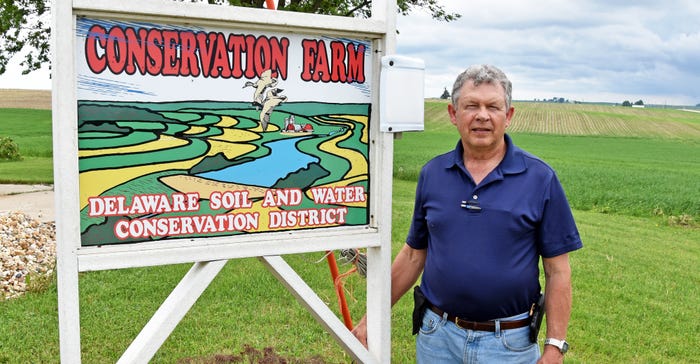June 11, 2018

By Jason Johnson
Any farmer who has planted no-till soybeans into heavy cornstalk residue knows it can be challenging. Delays can occur when standing cornstalks force chains off drive sprockets, crop residue jams row cleaners, or sprockets break.
According to Delaware County farmer and soil conservationist Wayne Brunsman, the key to easing tough no-till planting conditions is improving soil biology.
Brunsman is a veteran farmer who also serves as a technician with the Delaware Soil and Water Conservation District. He has continuously no-tilled about 300 acres for 14 years, and he added cereal rye cover crops to his corn-soybean system in 2013.
Bacteria, protozoa, microscopic insects, earthworms, beetles, ants, mites and fungi are beneficial organisms that are part of the soil food web that cycle nutrients. Brunsman says keeping life in the soil and disturbing the soil as little as possible builds soil biology over time. Bacteria, fungi and nematodes feed on residue, roots and other dead organic matter in the process.
Tillage destructive to soil system
“Like other living creatures, the organisms in the soil also need food and shelter,” he says. “These organisms then help with decomposition to allow the no-till planter to sail across the field.”
Brunsman says soil is full of life, if managed properly. “This is a major consideration for producers who are farming with healthy soils in mind,” he notes. “These farmers understand that tillage is disruptive to soil microbes and destructive to the soil system.”
Helping his neighbor plant no-till soybeans into standing cornstalks for the first time this spring reminded Brunsman of the importance of soil biology for better no-till planting conditions. “Planting out there was very frustrating. I had to stop every few hundred feet because the stalks jammed row cleaners and started pushing piles that needed to be cleared after lifting the planter,” he says. “It was an absolute nightmare! For the main body of the field, I decided to angle across the rows.”
Brunsman says the neighbor’s residue conditions were very different from his. “The stalks were very hard, and laying in a twisted pattern off the ground,” he says. “They were not distributed very well, with a thick mat between some rows and little in others, with varying soil moisture conditions.”
No-till, covers build soil health
Brunsman then headed over to his own farm to start planting no-till soybeans into a well-developed cereal rye cover crop and corn residue. “I planted everything with the row, not across as I had done for the neighbor,” Brunsman says. “I sailed through everything without stopping, even as a light rain spattered my planter. I was amazed!”
When he later inspected his field’s residue, he observed it was every bit as thick as the neighbor’s. “The difference was eye-opening. While my neighbor’s crop residue was still standing in the air, mine was pulled down tightly to the ground by soil critters,” Brunsman says.
When he grabbed a handful of stalks, what looked to be intact stalks from above was shredded from the bottom side — evidence of healthy soil biology. “It was all intertwined with cereal rye growing through it,” he says. “All of that allowed me to plant right through it without incident. It was another case of not being able to see the biology directly, but seeing the results of their presence.”
Best way to improve soil biology
Brunsman recommends farmers begin managing the entire soil profile, instead of just the mineral portion. “Most farmers are missing a huge opportunity by failing to use soil biology,” he says. “We can make a lot of money, save a lot of soil, retain a lot more rainwater and get more consistent yields by managing the entire soil profile.”
Neil Sass, an agronomist for USDA’s Natural Resources Conservation Service in West Union, Iowa, says the best way to improve soil biology and, in turn, no-till planting conditions is to have a holistic, system-approach to managing the soil. “It may take a few years to improve soil conditions,” he says. “But the more practices you adopt to improve the soil, the faster conditions will improve.”
Sass recommends these five steps for improving soil biology:
• Manage the soil more by disturbing it less.
• Keep the soil covered.
• Keep a living root in the soil by planting cover crops.
• Add diversity to the soil with more than just corn and soybeans.
• Incorporate livestock to the system or apply manure to the soil.
For more information about improving soil biology, visit your local NRCS office or go to ia.nrcs.usda.gov.
Johnson is a public affairs specialist for USDA Natural Resources Conservation Service in Des Moines.
You May Also Like




